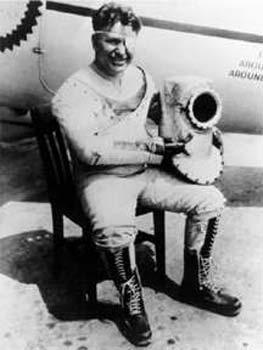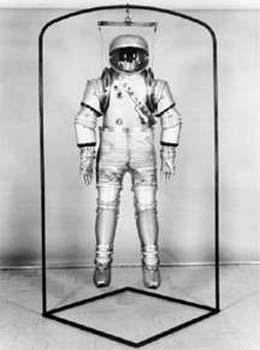Source: NASA
09-19-2008 15:40
The Extravehicular Mobility Unit worn during spacewalks by NASA's Space Shuttle astronauts represents more than 60 years of development and testing of pressure suits in the U.S., Russia, France, Italy, Germany, and other countries. It all began with high-altitude flyers, and one of the first was an American, Wiley Post. Post, an aviation pioneer of the 1930s, was seeking to break high-altitude and speed records. Post, as well as others, knew that protection against low pressure was essential. Through experience, aviators had learned that Earth's atmosphere thins with altitude.At 5,500 meters, air is only one-half as dense as it is at sea level. At 12,200 meters, the pressure is so low and the amount of oxygen is so small that most living things perish. For Wiley Post to achieve the altitude records he sought, he needed protection. (Pressurized aircraft cabins had not yet been developed.) Post's solution was a suit that could be pressurized by his airplane engine's supercharger.
 |
| Aviation pioneer Wiley Post. |
First attempts at building a pressure suit failed since the suit became rigid and immobile when pressurized. Post discovered he couldn't move inside the inflated suit, much less work airplane controls. A later version succeeded with the suit constructed already in a sitting position. This allowed Post to place his hands on the airplane controls and his feet on the rudder bars. Moving his arms and legs was difficult, but not impossible. To provide visibility, a viewing port was part of the rigid helmet placed over Post's head. The port was small, but a larger one was unnecessary because Post had only one good eye!
During the next 30 years, pressure suits evolved in many ways and technical manufacturing help was gained from companies that made armor, diving suits, galoshes, and even girdles and corsets. Designers learned in their search for the perfect suit that it was not necessary to provide full sea-level pressure. A suit pressure of 24.13 kilopascals (sea level- 101 kilopascals) would suffice quite nicely if the wearer breathed pure oxygen. Supplying pure oxygen at this low pressure actually provides the breather with more oxygen than an unsuited person breathes at sea level. (Only one-fifth of the air at sea level is oxygen.)
Various techniques were used for constructing pressure garments. Some approaches employed a rigid layer with special joints of rings or cables or some other device to permit limb movements. Others used non-stretch fabrics- laced-up corset fashion.
 |
| Early spacesuit design |
With the advent of pressurized aircraft cabins, comfort and mobility in the suit when it was unpressurized became prime objectives in suit design. The suit could then be inflated in the event that the aircraft cabin lost pressure.
